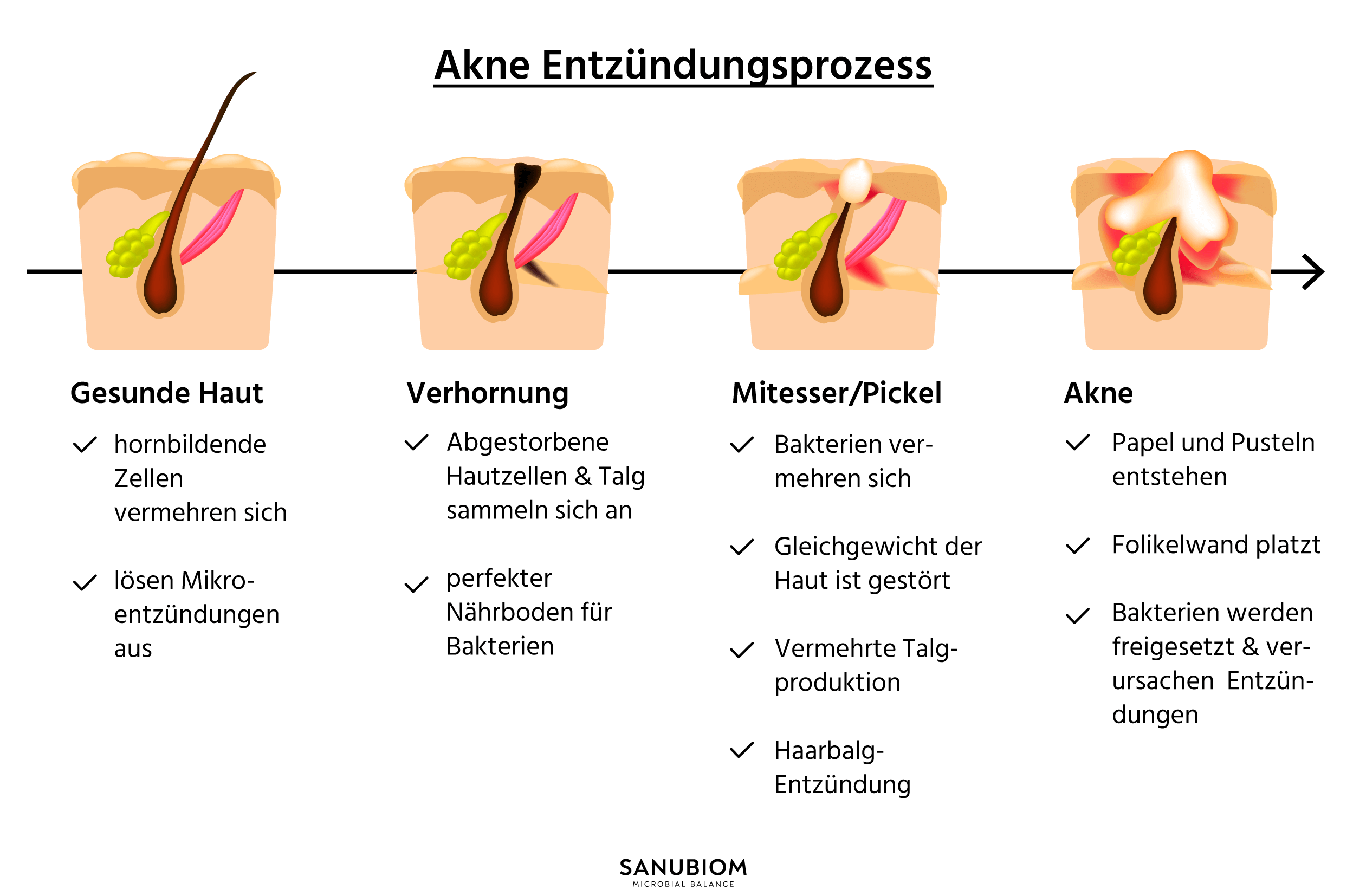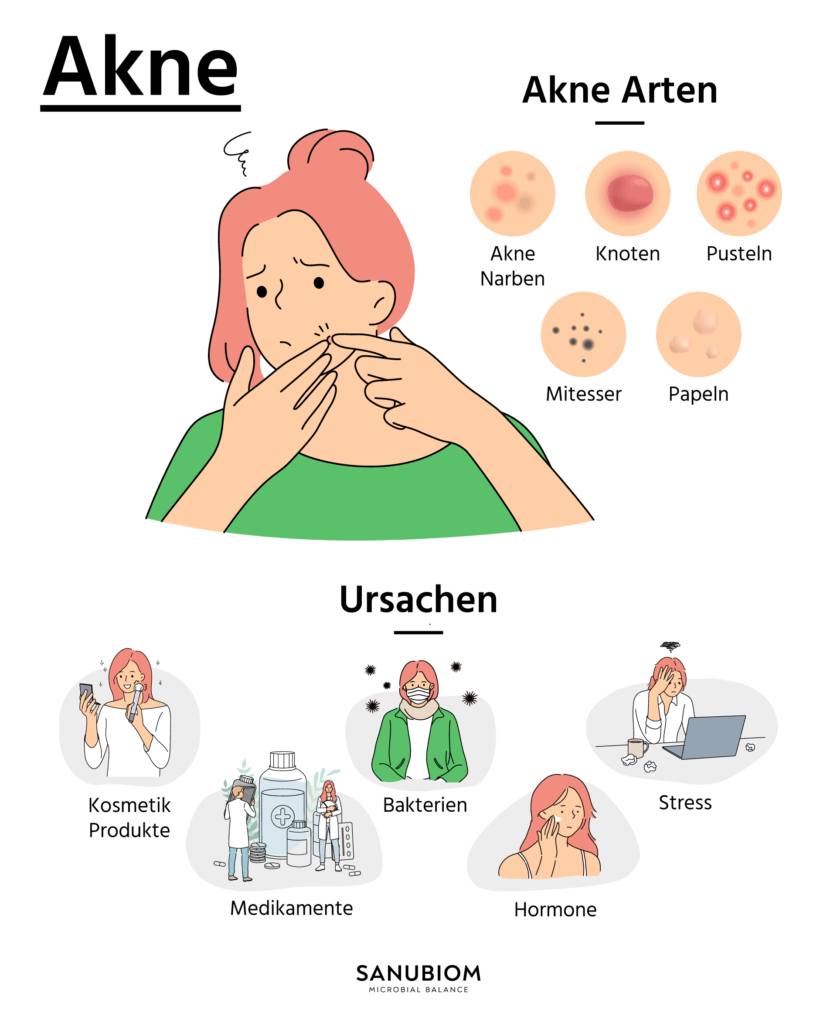Acne is an inflammation of the skin. Visible acne begins with microscopically small preliminary stages of acne, the so-called microcomedones.
These are accompanied by the first small inflammations. As the disease progresses, the inflammatory reaction becomes stronger.
Hormonal changes, environmental influences or certain medications can cause increased sebum production. This change is then ultimately the basis for the growth of bacteria.
Visible inflammations in the form of pimples develop.


Everyone knows pimples and nobody wants them. They arise in a very complex process and many influencing factors play a role here.
In technical jargon, pimples are also called papules or pustules. It all starts with the so-called microcomedones.
These are microscopically small and only microscopically detectable preliminary stages of acne. Microcomedones occur in all skin.
They are formed by the proliferation of horn-forming cells. In healthy skin they dissolve; in susceptible skin, on the other hand, inflammatory reactions, also known as micro-inflammations, occur. This is how the first symptoms of acne develop.
Ultimately, various factors play a role in the development of pimples.
Factors that play a role in the development of spots:
These factors can contribute to an increase in horny cell production and the production of sebum.
The increased production of sebum is an ideal prerequisite for the growth of bacteria.
The overgrowth of bacteria then causes visible inflammation in the form of pimples.

Blackheads (comedones) are also called microcomedones and cause initial inflammatory reactions.
These inflammations are usually the first invisible symptom of developing acne. They are due to predisposition or hormonal changes.
External factors such as stress, diet, certain foods or smoking can then promote the visible inflammation of acne.
Microcomedones can cause an increased formation of horny cells that block the outlet of the sebaceous glands.
Dead skin particles can no longer be shed and the flow of sebum is disrupted.
This causes small “plugs” to form, the so-called comedones.
This process stimulates the sebaceous glands. Even more sebum is produced and redness, pimples and blackheads appear on the surface of the skin.
These blackheads are usually visible on the face, back, neck or décolleté.
Various acne diseases can be attributed to inflammatory reactions:

Acne occurs most frequently on the body where there are many sebaceous glands.
On the face, neck, décolleté, back and outer upper arms.
However, acne can also occur under the armpits, in the genital area, on the buttocks or in the groin area.
This form of acne is called acne inversa and is caused by an inflammation of the hair follicle.
This is a different disease from acne, which is caused by a disease of the sebaceous glands.
We would therefore strongly advise you to see a doctor or specialist if you have symptoms of acne inversa. In this way, acne can be treated effectively.
Acne is usually diagnosed by looking at the characteristic pimples and blackheads.
But other aspects are also important.
Aspects that play a role in the diagnosis of “acne”:

Too many bacteria cause the skin to become unbalanced. If the bacterial balance of the skin is disturbed, micro-inflammations are promoted and the first acne symptoms develop.
The accumulation of sebaceous gland secretions due to blocked sebaceous glands creates an ideal breeding ground for bacteria.
Some bacteria multiply particularly well in blackheads. Furthermore, the decomposition of sebum produces free fatty acids, which promote further inflammation.
The growth of the bacteria triggers an immune reaction, which becomes visible as inflammation on the surface of the skin in the form of pimples.
If the pimples remain closed, the surrounding skin tissue also becomes inflamed and redness occurs.
For mild to moderate acne, home remedies or our“Tips on how to get rid of your acne” can be helpful.
In severe cases or with severe acne, the follicle wall can rupture.
Fatty acids, bacteria and horny cells are released and usually trigger extensive inflammation in the surrounding tissue.
Curing this form of acne is somewhat more challenging, but not impossible.
Bacteriophages are specialized in killing harmful bacteria (e.g. Staphylococcus aureus, Propionibacterium acnes) and sparing the good and beneficial bacteria (e.g. aerobic corynebacteria and lipophilic bacteria).
Phages on our skin ensure that the balance is maintained.
If the balance has become imbalanced due to inflammation or bacterial infestation, the use of phages can be a solution.
With our probiotic skin protection Sanubiom SkinCare Protect, we help you to reduce the feeling of tightness on the skin, skin irritation and redness.
The targeted use of phages can reduce inflammation on the skin affected by acne. Your skin is finally at peace again.

Author: Martin Müller
“Various internal and external influences can cause our microbial balance to become unbalanced. Harmful bacteria get out of hand and skin irritations such as redness, itching and eczema are the result. “
Share post: